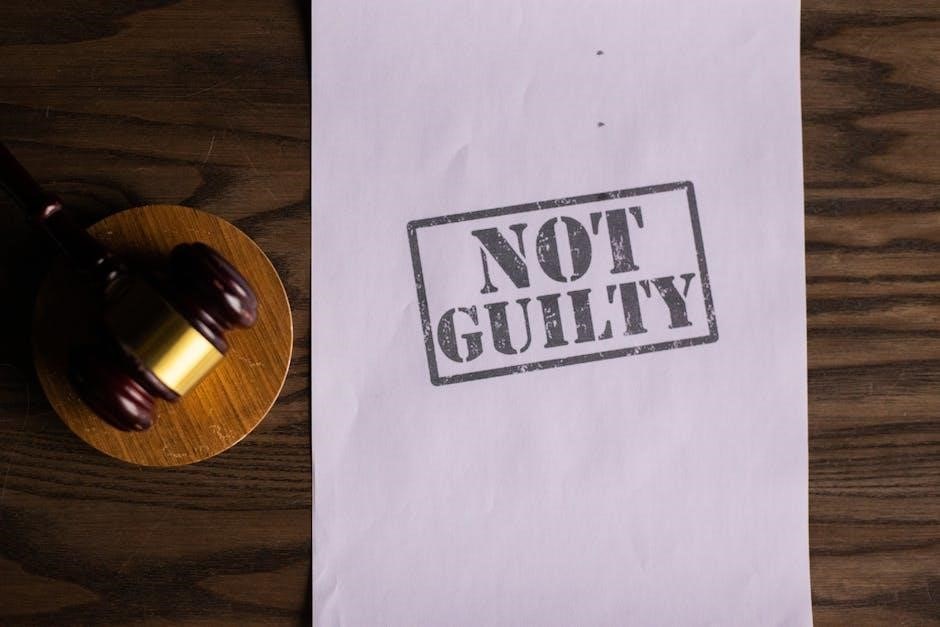The 9th Edition of Criminal Law: Cases and Materials offers a comprehensive exploration of criminal law principles, defenses, and specific offenses, updated with recent legal developments and landmark cases.
1.1 Overview of the 9th Edition
The 9th Edition of Criminal Law: Cases and Materials provides a thorough update on criminal law principles, incorporating recent legislative reforms, landmark Supreme Court decisions, and technological advancements. It covers fundamental concepts such as actus reus, mens rea, and causation, while also addressing defenses like insanity and self-defense. The edition includes analysis of specific crimes, including homicide, sexual assault, and property offenses, offering a balanced approach to both substantive law and procedural aspects.
1.2 Authors and Contributors
The 9th Edition of Criminal Law: Cases and Materials is authored by distinguished legal scholars Joshua Dressler and Stephen P. Garvey. Their expertise in criminal law and procedure ensures a comprehensive and insightful analysis. Contributors include prominent legal academics and practitioners who provide updated case law and statutory materials, enhancing the textbook’s depth and relevance for students and scholars alike.
1.3 Key Features of the Edition
The 9th Edition of Criminal Law: Cases and Materials features updated case law, statutory materials, and analysis of recent legal developments. It includes a comprehensive table of cases, detailed annotations, and practical applications of legal doctrine. The edition also offers a pedagogical approach with teaching aids, making it an essential resource for law students and scholars seeking a thorough understanding of criminal law principles and their real-world implications.

Fundamental Principles of Criminal Liability
Actus reus and mens rea form the cornerstone of criminal liability, requiring a prohibited act and guilty mind. Causation links the act to the harm, while strict liability offenses omit mens rea.
2.1 Actus Reus and Mens Rea
Actus reus refers to the prohibited act or omission, while mens rea denotes the guilty mind or intent. Together, they form the foundation of criminal liability, ensuring that both unlawful conduct and culpable mental states are established. The 9th Edition explores these principles in depth, analyzing their application in various offenses and the challenges of proving intent in modern legal cases. This dual requirement safeguards against unjust convictions, emphasizing the necessity of both action and intention in criminal wrongdoing.
2.2 Causation in Criminal Law
Causation in criminal law establishes a direct link between the defendant’s actions and the resulting harm. It involves both factual causation (whether the act caused the result) and legal causation (whether the result was foreseeable). Courts often apply tests like “but for” and “proximate cause” to determine liability. The 9th Edition delves into complexities such as intervening acts and multiple causes, highlighting the challenges of proving causation in modern criminal cases and its implications for justice.
2.3 Strict Liability Offenses
Strict liability offenses are crimes where intent (mens rea) is not required; the mere commission of the act (actus reus) is sufficient for conviction. These offenses often involve regulatory or public welfare violations, such as statutory rape or selling alcohol to minors. The 9th Edition examines the rationale behind strict liability, its application in modern law, and the debates surrounding its fairness, providing insights into how these offenses fit within the broader criminal justice framework.

Defenses in Criminal Law
Defenses in criminal law include insanity, self-defense, duress, and mistake of fact, each addressing different circumstances that may absolve or mitigate criminal liability, explored in detail.
3.1 Insanity Defense
The insanity defense is a legal argument that a defendant was not criminally responsible due to a mental disorder. It varies by jurisdiction, with some using the M’Naghten rule, which focuses on the ability to understand right from wrong, while others employ the ALI standard, considering whether the defendant could conform their conduct to the law. Courts often require expert testimony to assess mental state at the time of the crime, making it a complex and controversial defense.
3.2 Self-Defense and Necessity
Self-defense and necessity are legal defenses that justify otherwise criminal conduct. Self-defense requires an imminent threat, a reasonable belief of harm, and a proportional response. Necessity involves choosing the lesser evil to avoid harm, like breaking the law to prevent greater danger. Both defenses must meet strict legal standards, and courts carefully assess whether the actions were reasonable and necessary. These doctrines balance individual rights with societal safety, raising complex ethical and legal questions in criminal law.
3.3 Duress and Mistake of Fact
Duress and mistake of fact are defenses that negate criminal liability under specific circumstances. Duress involves being forced to commit a crime due to a direct threat of imminent harm, requiring the threat to be immediate and unavoidable. A mistake of fact occurs when the defendant holds a mistaken belief about facts, which, if true, would make the conduct lawful. Both defenses require clear evidence and are subject to strict legal scrutiny to ensure justice and fairness in criminal proceedings.

Specific Crimes and Offenses
This section examines homicide, sexual assault, and property offenses, providing detailed analysis of their legal elements, defenses, and sentencing considerations in modern criminal law frameworks.
4.1 Homicide: Murder and Manslaughter
The 9th Edition thoroughly examines the legal distinctions between murder and manslaughter, focusing on elements like malice aforethought, intent, and recklessness. It includes case law illustrating the nuances of homicide, such as the role of provocation, heat of passion, and unlawful act doctrine. The section also explores sentencing implications and the impact of recent legal reforms on homicide classifications, providing a comprehensive understanding of this critical area of criminal law.
4.2 Sexual Assault and Related Offenses
The 9th Edition delves into the complexities of sexual assault and related offenses, examining the legal elements of consent, intent, and the actus reus. It explores defenses such as mistaken belief in consent and the impact of recent legislative reforms. The section also addresses the role of technology in evidence collection and the evolving definitions of sexual offenses. Case studies highlight the challenges of prosecution and the societal implications of these crimes, emphasizing the need for a nuanced legal approach.
4.3 Property Offenses: Theft and Burglary
The 9th Edition thoroughly examines property offenses, focusing on the elements of theft and burglary. It explores the actus reus and mens rea required for these crimes, including the intent to permanently deprive in theft and the trespassory entry in burglary. The section also discusses recent legal developments, such as reforms to burglary laws and the impact of technology on property crime prosecution. Case studies illustrate the practical application of these doctrines in modern criminal law contexts.

Criminal Law and Procedure

The 9th Edition examines key aspects of criminal procedure, including constitutional protections, sentencing reforms, and the role of the jury, providing updated case law and analysis.
5.1 Constitutional Protections in Criminal Proceedings
The 9th Edition thoroughly examines constitutional protections in criminal proceedings, focusing on the Fourth, Fifth, and Sixth Amendments. It explores due process, the right to counsel, and safeguards against unlawful searches and self-incrimination. Recent judicial interpretations and landmark cases, such as Miranda v. Arizona, are analyzed to illustrate the evolving nature of these rights. This section provides a foundational understanding of how constitutional principles shape criminal procedure, ensuring fairness and justice.
5.2 Sentencing and Penal Policy
The 9th Edition delves into sentencing and penal policy, exploring frameworks for punishment, deterrence, and rehabilitation. It examines sentencing discretion, mandatory minimums, and recent reforms aimed at reducing mass incarceration. Key discussions include the role of sentencing guidelines, plea bargaining, and the impact of penal policies on racial and socioeconomic disparities in the criminal justice system. This section also addresses the balance between punishment and rehabilitation in modern penal systems.
5.4 The Role of the Jury in Criminal Trials
The 9th Edition examines the pivotal role of the jury in criminal trials, focusing on jury selection, deliberation processes, and verdict delivery. It discusses legal standards for jury impartiality and the impact of jury nullification. The section also explores modern challenges, such as ensuring diverse representation and addressing biases, while highlighting the jury’s role in upholding justice and public trust in the legal system.

Recent Developments in Criminal Law
This section covers recent developments in criminal law, including legislative reforms, landmark Supreme Court cases, and technological advancements impacting criminal justice and legal frameworks.
6.1 Legislative Reforms and Their Impact
Recent legislative reforms in criminal law, such as changes to sentencing guidelines and penal codes, have significantly influenced legal frameworks. These reforms aim to address fairness, proportionality, and modern societal needs. For instance, adjustments to penal codes like Section 1170(b) now grant judges greater discretion in sentencing, reflecting a shift toward more individualized justice. These changes are thoroughly analyzed in the 9th Edition of Criminal Law Cases and Materials, providing insights into their practical implications for criminal justice systems. The text highlights how these reforms align with contemporary legal principles and their effects on judicial decision-making processes. Such updates ensure that legal education remains aligned with evolving laws and practices, preparing future legal professionals to navigate the complexities of criminal law effectively. The 9th Edition thus serves as a vital resource for understanding these dynamic changes and their broader impact on society.
6.2 Landmark Supreme Court Cases
The 9th Edition of Criminal Law Cases and Materials extensively covers landmark Supreme Court cases such as Miranda v. Arizona and Brady v. Maryland. These cases have profoundly influenced criminal procedure and the rights of the accused. The textbook provides in-depth analysis of these rulings, offering insights into their significance and application in modern legal contexts. This comprehensive coverage aids in understanding how these decisions continue to shape criminal justice systems today.
6.3 Technological Advancements in Criminal Justice
Recent advancements in technology have significantly impacted criminal justice, as discussed in the 9th Edition. Digital evidence handling, AI-driven predictive policing, and surveillance tools are transforming investigations. The textbook explores how these innovations improve efficiency but also raise concerns about privacy and ethical implications. It highlights the balance between leveraging technology for justice and safeguarding individual rights in a rapidly evolving legal landscape.

Case Studies and Materials
Case Studies and Materials in the 9th Edition provide in-depth analyses of landmark cases, offering practical insights into judicial decisions and their real-world applications in criminal law.
7.1 Notable Cases in the 9th Edition
The 9th Edition features landmark cases that shape criminal law doctrine, including decisions on homicide, sexual assault, and property offenses. These cases highlight judicial reasoning and legal trends, providing insights into evolving interpretations of criminal liability and defenses. Recent Supreme Court rulings are included, offering students a comprehensive understanding of contemporary legal issues. The cases are analyzed for their practical implications, bridging theory and real-world application. This section is invaluable for understanding the dynamic nature of criminal law.
7.2 Analysis of Key Judicial Decisions
The 9th Edition provides in-depth analysis of key judicial decisions, offering insights into landmark rulings that shape criminal law. These decisions address critical issues such as homicide, sexual assault, and property offenses, reflecting evolving legal interpretations. The analysis highlights judicial reasoning, legal standards, and their practical implications, ensuring a thorough understanding of how courts interpret criminal liability and defenses. This section is essential for grasping the complexities of judicial decision-making in criminal law.
7.3 Practical Applications of Legal Doctrine
The 9th Edition emphasizes practical applications of legal doctrine, illustrating how theoretical concepts apply in real-world scenarios. Through case studies and hypotheticals, students explore how criminal law principles are implemented in trials, sentencing, and legal strategies. This focus on practicality bridges the gap between theory and practice, preparing learners for professional challenges in criminal law. The material encourages critical thinking and problem-solving, essential for future legal professionals.

The Structure of Criminal Law Cases and Materials
The textbook is logically organized, with chapters progressing from foundational concepts to detailed analysis of specific crimes and defenses, supported by key cases and statutory materials.
8.1 Organization of the Textbook
The 9th Edition is structured to facilitate a clear understanding of criminal law, with chapters systematically covering foundational principles, specific offenses, defenses, and procedural aspects. Each section builds logically, starting with core concepts like actus reus and mens rea, then progressing to detailed analyses of homicide, sexual assault, and property crimes. The textbook integrates landmark Supreme Court cases and statutory materials to provide a comprehensive legal framework.
8.2 Use of Case Law and Statutory Materials
The 9th Edition extensively incorporates landmark Supreme Court cases and statutory provisions, such as Penal Code 1170(b), to illustrate legal principles. Case law is presented to highlight judicial interpretations, while statutory materials provide the foundational framework of criminal law. This dual approach ensures students can analyze legal doctrines in both theoretical and practical contexts, fostering a deeper understanding of how the law is applied in real-world scenarios.
8.3 Pedagogical Approach and Teaching Aids
The 9th Edition employs an engaging pedagogical approach, featuring structured case analyses and comprehensive teaching aids. It includes a Table of Cases for quick reference and integrates discussions on sentencing policies and penal reforms. The textbook is supplemented with PDF downloads and online resources, offering flexible learning options for students. These tools enhance understanding and facilitate critical thinking, making it an invaluable resource for criminal law education.

The Impact of the 9th Edition on Legal Education
The 9th Edition has significantly influenced legal education, offering updated content that aligns with modern criminal law practices and scholarly insights, enhancing student engagement and academic rigor.
9.1 Adoption in Law Schools and Universities
The 9th Edition of Criminal Law: Cases and Materials has been widely adopted in law schools and universities due to its comprehensive updates, clear explanations, and inclusion of landmark cases. Its structured approach aligns with modern curricula, making it a preferred resource for both students and faculty. The text’s availability in digital formats, including PDF, enhances accessibility and convenience for legal education worldwide.
9.2 Reviews and Feedback from Legal Scholars
Legal scholars have praised the 9th Edition of Criminal Law: Cases and Materials for its comprehensive updates and clear presentation of complex legal concepts. The inclusion of landmark cases and modern legal developments has been particularly commended. Scholars appreciate its effectiveness in engaging students and facilitating deeper understanding of criminal law principles. The availability of the text in PDF format has also been highlighted as a convenient resource for academic use.
9.3 Role in Shaping Criminal Law Curriculum
The 9th Edition of Criminal Law: Cases and Materials has significantly influenced the development of criminal law curricula across law schools. Its structured approach to fundamental principles, defenses, and specific offenses provides a robust framework for teaching. The inclusion of modern case law and statutory updates ensures students are well-prepared for contemporary legal challenges. This textbook is widely adopted, shaping syllabi and fostering critical thinking in future legal professionals.
The 9th Edition of Criminal Law: Cases and Materials is a comprehensive resource, updated with modern legal developments, offering insights into criminal law principles, defenses, and specific crimes, essential for legal education.
10.1 Summary of Key Themes
The 9th Edition of Criminal Law: Cases and Materials provides a thorough analysis of criminal law, covering foundational concepts like actus reus, mens rea, and causation. It explores defenses such as insanity, self-defense, and duress, along with specific crimes like homicide and sexual assault. The text also addresses recent legislative reforms, landmark Supreme Court decisions, and technological advancements in criminal justice, offering a comprehensive and updated understanding of criminal law principles and their practical applications.
10.2 Future Directions in Criminal Law Scholarship
Future scholarship in criminal law is expected to focus on emerging technologies, AI, and forensic science. Legislative reforms and their impact on criminal justice will remain a key area of study. Interdisciplinary approaches, blending law with psychology and sociology, will deepen understanding of criminal behavior. Additionally, empirical research on sentencing and penal policy will inform evidence-based reforms, ensuring criminal law adapts to societal changes while upholding justice and human rights.
10.3 Final Thoughts on the 9th Edition
The 9th Edition of Criminal Law: Cases and Materials is a seminal resource for legal education, offering insightful analysis and comprehensive coverage of criminal law. Its integration of landmark cases and recent reforms ensures relevance and depth. Scholars and students alike will find it invaluable for understanding both foundational principles and contemporary issues in criminal justice, making it a cornerstone of legal scholarship and education for years to come.





